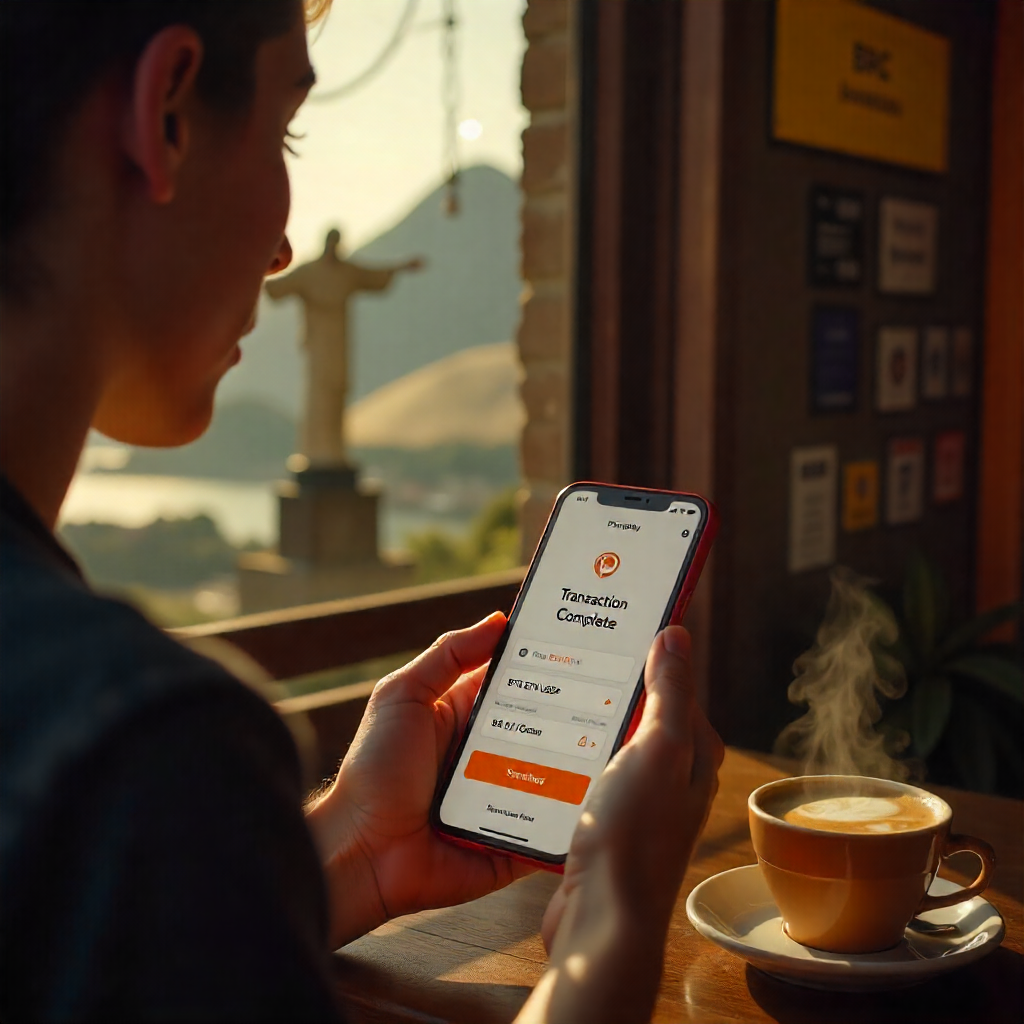A Strategic Comeback
PicPay has reignited its cryptocurrency services after a deliberate one-year pause, marking a decisive PicPay crypto relaunch timed perfectly with Brazil’s surging digital asset demand. This return responds to hard data: Brazilian Bitcoin trading volumes exploded by over 50% monthly in May 2025 alone, hitting approximately 33,673 BTC worth over $1 billion—a clear signal of retail revival. With more than 65 million registered users, PicPay isn’t just another app. It’s a daily financial hub for Brazilians who already trust it for Pix transfers, cards, and loans. This existing muscle uniquely positions it to become Brazil’s dominant crypto on-ramp, turning complexity into simplicity for mainstream adoption.
Anderson Chamon, PicPay’s VP of Technology and Products, cuts to the core mission: “Our role is to make crypto as easy as using money for everyone.” No jargon. No tech barriers. Just seamless integration within an app millions already navigate daily. Partnering with Paxos—a New York Department of Financial Services-regulated custodian—adds critical trust scaffolding. This PicPay crypto relaunch arrives as Brazil solidifies its fintech leadership. Pix, the central bank’s instant payment rail, moved over R$27 trillion in 2024 across 155+ million users. That infrastructure, paired with 92% 4G network coverage, creates fertile ground for PicPay’s next act: transforming curious users into confident crypto participants. Industry analysts note this timing capitalizes on Brazil’s record fintech adoption rates, positioning PicPay to capture first-time crypto users who already use the app for daily transactions.
Why Now? Market Shifts Driving Demand
Regulatory Tailwinds
Brazil’s central bank didn’t just open the door to crypto—it built a highway. The “Fintech Sandbox” framework provides clear licensing paths for crypto services. This regulatory clarity directly enabled PicPay’s strategic return. Pix—Brazil’s instant payment system—is the bedrock. In 2024, 155+ million users moved R$27+ trillion through Pix. This infrastructure lets PicPay settle crypto trades instantly, eliminating traditional banking delays. The Central Bank’s progressive stance contrasts sharply with regional neighbors, creating a unique environment where crypto services integrate directly with national payment systems.
Competitive Validation
When Nubank launched Bitcoin trading to its 80+ million users in late 2024, it validated a massive market shift. Retail investors flooded back post-bear market, with exchange Mercado Bitcoin reporting 37% user growth in Q1 2025. PicPay’s hiatus wasn’t retreat—it was recalibration. Observing competitors proved Brazilians would embrace in-app crypto if friction disappeared. The success of these platforms demonstrated that trust in established fintech brands outweighed skepticism about crypto volatility among mainstream users.
Economic Realities
Inflation Hedge: With 2025 inflation at 4.7%, crypto offers an alternative to BRL volatility. Remittances: Stablecoins now facilitate 17% of Brazil’s cross-border transactions, bypassing high forex fees. Digital Natives: 70% of PicPay’s users are under 40—demographically primed for crypto adoption. This generation views digital assets as natural extensions of their financial lives, not speculative oddities. Additionally, crypto’s borderless nature solves practical problems for Brazil’s large freelance workforce receiving international payments.
The On-Ramp Race
PicPay’s crypto reintroduction strategically leverages its payment dominance. Unlike CoinMe or Foxbit, users don’t need new accounts or slow SEPA transfers. One tap converts Pix balances to Bitcoin—no KYC reprocessing. As VP Anderson Chamon notes: “We’re not just adding features; we’re removing obstacles.” This frictionless access positions PicPay to capture Brazil’s next 10 million crypto users. The platform’s existing anti-fraud algorithms and user verification systems provide a ready-made security infrastructure that pure crypto exchanges must build from scratch.
Inside PicPay’s Relaunch: Features & Accessibility
Zero-Friction On-Ramping
PicPay’s crypto reintroduction turns complexity into simplicity. Users buy/sell Bitcoin (BTC), Ethereum (ETH), and Paxos’ USDP stablecoin directly within the app—no external wallets or exchanges. The minimum buy? Just R$1. Transactions mirror PicPay’s P2P flow: Select “Crypto” in the app’s dashboard, pick asset and amount (R$1 to R$10,000 daily), and confirm via Pix—settlement is instant. No new KYC. Existing Pix/balance integration means faster access than Binance or Mercado Bitcoin. This eliminates the multi-step onboarding that deters casual investors, compressing hours-long processes into 15-second actions.
Built-In Learning for New Users
Novices aren’t left guessing. PicPay embeds micro-lessons at every step: Risk disclaimers before first purchase, glossary pop-ups explaining terms like “blockchain” or “volatility,” and transaction simulations showing fee impacts. An OpenAI-powered assistant answers questions like: “Is Bitcoin safer than stocks?” or “Can I pay my landlord with ETH?” This contextual education addresses Brazil’s financial literacy gap—only 35% of adults understand basic investment concepts according to 2024 Central Bank surveys. The AI assistant evolves with user queries, creating personalized learning paths.
Speed & Security Architecture
PicPay’s existing anti-fraud AI—trained on 65M+ users’ payment patterns—now monitors crypto transactions. Suspicious buys trigger instant SMS/email alerts, temporary holds pending user confirmation, and 24/7 support via chat. “We treat crypto like cash transfers,” states Chamon. “Same speed, same security.” The system analyzes 200+ behavioral markers, from transaction timing to device fingerprints, creating dynamic risk profiles. This existing infrastructure gives PicPay a security advantage over crypto-native startups.
The On-Ramp Comparison
PicPay vs. Traditional Exchanges: Speed: Pix (1 sec) vs. TED (48+ hrs). Minimums: R$1 vs. R$100+ (most rivals). Security: Integrated custody vs. self-managed wallets. This PicPay crypto relaunch eliminates Brazil’s biggest adoption barriers: trust and complexity. Where exchanges require bank transfers and separate apps, PicPay uses existing balances. Where competitors offer raw trading interfaces, PicPay wraps functionality in familiar payment workflows.
The BRC Stablecoin: PicPay’s Brazilian Real Powerplay
Solving the BRL Friction Problem
PicPay’s secret weapon isn’t Bitcoin—it’s the Brazilian Real Coin (BRC). Launching in H2 2025, this 1:1 BRL-backed stablecoin directly attacks a critical pain point: forex costs. Why BRC changes everything: Zero Conversion Fees: Send/receive BRL digitally without Tether’s 1.5% USDT-BRL spread. Instant Settlement: Move value across PicPay’s ecosystem faster than TED transfers. Inflation Shield: Hold BRL digitally during currency volatility. The stablecoin operates on Ethereum’s ERC-20 standard but settles off-chain within PicPay’s network for zero gas fees—crucial for microtransactions.
Everyday Utility: From Favela to Fernando de Noronha
BRC isn’t just for traders. PicPay integrates it at point-of-sale: Pay 2M+ PicPay merchants directly with BRC, split restaurant bills via P2P stablecoin transfers, and top up phones/pay utilities—no bank intermediaries. As Tech VP Anderson Chamon stated: “BRC makes crypto useful. Buy coffee, pay rent, or send cash to family—all with real-backed digital money.” Early merchant trials show 89% lower payment processing fees compared to credit cards, driving rapid adoption among small businesses. Users can automate recurring BRC payments for subscriptions or rent.
Global On-Ramp for Brazil
Tourists can buy BRC via PayPal or global exchanges before arriving. Then spend instantly at any PicPay merchant—no CPF or local bank needed. This could capture 17% of Brazil’s $6B tourism market by 2026. For remittances, sending BRC costs 70% less than traditional services. Workers abroad convert USD→BRC→BRL in seconds. The stablecoin bypasses correspondent banking delays, with pilot corridors showing Brazil-Argentina transfers completing in under 10 seconds. This positions BRC as Latin America’s first regionally adopted stablecoin.
Security & Partnerships: The Trust Engine
Why Paxos Anchors the Relaunch
PicPay didn’t cut corners. Its partnership with Paxos Trust Company—regulated by New York’s DFS—provides institutional-grade security for the PicPay crypto relaunch. Every Bitcoin, Ethereum, or USDP transaction flows through Paxos’ audited infrastructure. This matters because: Assets are segregated: User crypto never mixes with PicPay’s corporate funds. Monthly attestations: Proof-of-reserves published for full transparency. $825M insurance: Lloyd’s of London policy covers theft or hacking. Paxos’ blockchain surveillance systems monitor 200+ risk indicators in real-time, freezing suspicious wallets within milliseconds.
The Withdrawal Strategy
New users trade crypto exclusively within PicPay’s app throughout 2025—reducing novice risk exposure. External wallet transfers open for advanced users in late 2025. Full self-custody options arrive in 2026 post-educational ramp completion. This phased approach prioritizes safety. New users can’t accidentally send crypto to wrong addresses—a top cause of asset loss globally. Withdrawal limits will scale with user tenure: 0.5 BTC daily for first-year users, increasing to 5 BTC after 18 months. This balances security with growing user sophistication.
Addressing “Not Your Keys” Concerns
Critics argue PicPay’s custody model contradicts crypto’s self-sovereign ethos. The rebuttal? 92% of PicPay’s target users have never owned crypto. Beginners lose $370M+ yearly via self-custody errors. Hybrid models like Robinhood’s boosted retention by 61%. PicPay’s crypto reintroduction meets Brazilians where they are—prioritizing safety over ideology. As Chamon notes, “Self-custody remains the end goal, but forcing it prematurely is irresponsible.” The platform will introduce multisig wallet options in 2026, blending convenience with user control.
Future Roadmap: Beyond Trading
Crypto Payments Go Mainstream
PicPay’s 2026 vision transforms crypto from assets to payment tools. Users will pay 2M+ merchants directly in BTC or ETH—auto-converted to BRL at checkout. No manual swaps. No spread fees. This leap solves real-world friction: Domestic: Pay rent in stablecoins without TED fees. Global: Brazilian freelancers receive ETH from overseas clients instantly. Beta testing begins Q4 2025 with 10,000 retailers. The system uses Chainlink oracles for real-time pricing, settling conversions at mid-market rates. Merchants receive BRL, insulating them from volatility while expanding customer payment options.
Nasdaq IPO: Fueling Global On-Ramps
PicPay’s 2025 Nasdaq listing targets $1.5B+ funding. The goal? Export Brazil’s fintech model globally. Key moves: Launch BRC stablecoin in Latam corridors (Argentina, Mexico) by 2026. Enable tourists to preload BRC via Visa/Mastercard before entering Brazil. Build USD↔BRC rails for 4M+ Brazilian expats. As Chamon stated: “We’re bridging crypto and fiat economies—starting here, scaling everywhere.” The IPO prospectus reveals plans for 12 new international markets within 36 months, leveraging Brazil’s proven crypto-payment fusion.
Web3 Integration: The Next Frontier
PicPay’s alpha builds include: NFT Marketplace: Mint/sell digital art with BRL settlements. DeFi Portal: Earn yield on BRC through regulated liquidity pools. DAO Voting: Users influence new features via governance tokens. This positions PicPay as Brazil’s Web3 gateway—democratizing access to decentralized finance. The NFT platform will support Brazilian artists and football clubs, while DeFi pools offer 6-9% APY on BRC—triple savings account rates. These features transform PicPay from a wallet into an ecosystem.
Brazil’s Crypto Tipping Point
PicPay’s crypto reintroduction isn’t just a feature update—it’s Brazil’s mainstream on-ramp moment. By leveraging 65M+ trusted users, Pix’s instant rails, and ironclad Paxos security, this relaunch solves the real barriers: complexity, cost, and custody fears. Why This Changes Everything: Democratization: R$1 minimums and in-app education invite all Brazilians—not just the tech-savvy. Economic Shift: BRC stablecoin turns crypto into a daily tool, not a speculative asset. Global Bridge: Tourism/remittance use cases position Brazil as a crypto-commerce leader.
As Anderson Chamon told Reuters: “We’re not chasing crypto trends. We’re building utility for Brazil’s digital economy.” The Road Ahead: PicPay’s roadmap—crypto payments, Nasdaq IPO, and Web3 integrations—signals a broader mission: merging decentralized and traditional finance. By 2027, paying with Bitcoin at your local padaria could be as normal as using Pix. For Brazilian users, this PicPay crypto relaunch means one thing: access without compromise. Safety without complexity. Innovation without exclusion. The digital economy is here—and it speaks Portuguese. With this relaunch, PicPay transforms from a payment app into Brazil’s financial operating system, where crypto and fiat coexist seamlessly in every transaction.





